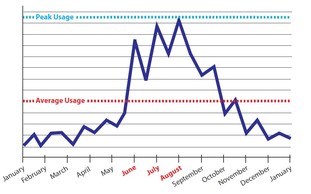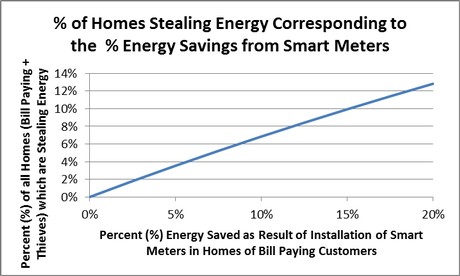RecoverIR™
Main menu:
- Home Page
- Services
- Detect Abandoned Homes
- Energy Theft
- Energy Efficiency
- Weatherization
- Lost Energy
- Smart Grid Financing
- PV Solar Plant Services
- Solar Plant Efficiency
- Solar Plant Commissioning Assessments
- Solar Plant Thermal Mapping
- Solar Investor/Owner Risk Reduction
- Solar Plant Conditioned Based Maintenance
- Solar Plant Reliability & Performance Trending
- Solar Inverter Performance Assessment
- Solar Plant Siiting & Performance Optimization Assistance
- Contact Us
- About Us
- Client Access
- Blog
Smart Grid Financing
Services
If a utility could save $100 million a year for 10 years, through the reduction of theft, the example utility would capture $1 billion toward the payment of smart meters and the natural gas, fuel oil and propane companies could save about $5 billion.
Transferring savings from apprehension of energy thieves to a utility’s plans to roll out smart meters and a smart grid to all utility customers may become a necessity since energy consumers in the USA and Europe are beginning to push back against the installations.
What are Smart Meters?
“’’Smart’meters are devices that can remotely report electricity and gas usage readings as often as hourly to utilities without the need for human meter readers. justifications offered by proponents are twofold. it is claimed that utilities can control electricity usage by sharply raising rates during hours of high system demand, thus discouraging consumption and reducing the need for additional generation capacity. customers can supposedly benefit by moving their usage to hours when demand and prices are low.”
So Why the Big Push for Smart Meters and Smart Grids?
The DOE pegged the capital, fuel costs, and carbon sequestration expense of additional peak power generating stations, to values as high as $200/kilowatts/year. The cost of the construction cost only of a 623.4 Mw by the DOE was pegged at $559 million plant without carbon dioxide sequestration systems, and a total cost of $1.26 billion for construction only for the same plant with CO2 sequestration and a net output of only 518.2 MW. No coal fired plants were built in 2010 in the U.S. It has become unattractive to plan to build large new electric plants. New plants are difficult to justify in the face of many of the new regulatory requirements for fossil plants, including carbon sequestration, and a continuing moratorium on nuclear plants. If a utility plans to buy peaking power to supplement shortfalls during peak demand, tiered pricing systems for electricity can double or quadruple the marginal cost of electricity in cents/kWh.
If a utility plans to buy peaking power to supplement shortfalls during peak demand, tiered pricing systems for electricity can double or quadruple the marginal cost of electricity in cents/kWh.
If no additional power is available then the utility must create controlled brownouts or blackouts.
So one of the widely accepted solutions is to change the behavior of the consumer and institute time-of-use billing practices to change behavior, and consumers cannot change behavior without the installation of smart meters and smart grids.
Quantify & Minimize Energy Theft
Since one of the main values of smart meters and smart grids is to flatten the summer electricity demand curve (which tends to peak between May and October each year in many states) identifying energy theft is very important.
Shift Savings from Energy Theft Reduction to Smart Meters & Smart Grid Programs
Many utilities could nearly pay for their smart meter program through curtailment of energy theft, and possibly recover even more, if utilities mitigated their theft, even if utilities experienced one half of the 19.3% theft rate that we found in Detroit for DTE Energy.
The relationship between the projected energy savings from smart meters and the percentage of all homes stealing an equivalent amount of energy is shown in the figure to the right. This means it takes a relatively low percentage of homes stealing energy to equal the expected energy savings from installation of smart meters in the homes of the bill paying customers. For example 13.6 homes equipped with smart meters would be equivalent to one home stealing energy, if all ten homes suddenly achieved a 10% annual energy savings, which is unlikely.
equivalent amount of energy is shown in the figure to the right. This means it takes a relatively low percentage of homes stealing energy to equal the expected energy savings from installation of smart meters in the homes of the bill paying customers. For example 13.6 homes equipped with smart meters would be equivalent to one home stealing energy, if all ten homes suddenly achieved a 10% annual energy savings, which is unlikely.
For example, a utility program costs to install over 130,000 smart meters might be bracketed between $48 million and $204 million or between $369 and $1,569 per home. If an example large utility ultimately installed smart meters in the homes of (for example) 3.4 million residential customers, the total cost for the smart meter program at $369 per home would be more than $1.2 billion and possibly much higher.
Using this example, a utility serving about 3.4 million residential customers, if 6.85% of the 3.4 million customers were stealing $600 of electricity per year (and $1,450 of natural gas, fuel oil, or propane per year) this would amount to (3,400,000 x 6.85% x $600 x 94%) = $131,355,600 of electricity stolen per year from the example utility (and correspondingly $337,705,000 of stolen natural gas, fuel oil, or propane).
Sub-Menu:
- Detect Abandoned Homes
- Energy Theft
- Energy Efficiency
- Weatherization
- Lost Energy
- Smart Grid Financing ←
- PV Solar Plant Services